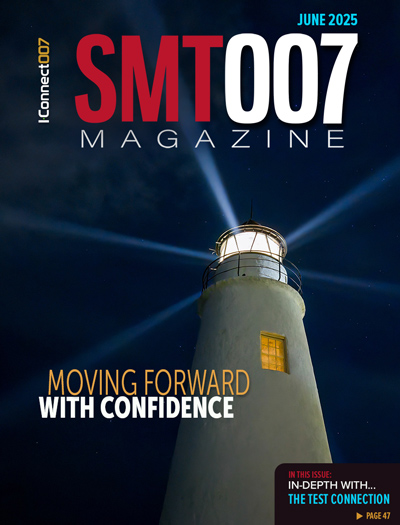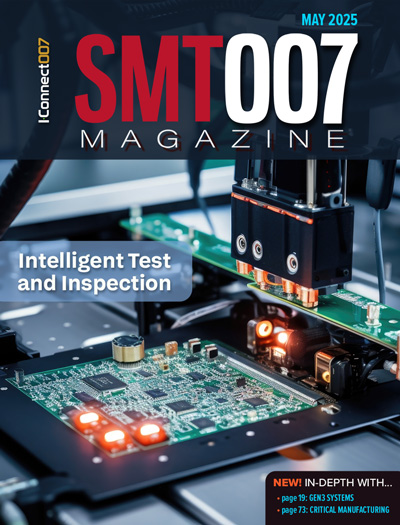-

- News
- Books
Featured Books
- smt007 Magazine
Latest Issues
Current Issue
What's Your Sweet Spot?
Are you in a niche that’s growing or shrinking? Is it time to reassess and refocus? We spotlight companies thriving by redefining or reinforcing their niche. What are their insights?

Moving Forward With Confidence
In this issue, we focus on sales and quoting, workforce training, new IPC leadership in the U.S. and Canada, the effects of tariffs, CFX standards, and much more—all designed to provide perspective as you move through the cloud bank of today's shifting economic market.

Intelligent Test and Inspection
Are you ready to explore the cutting-edge advancements shaping the electronics manufacturing industry? The May 2025 issue of SMT007 Magazine is packed with insights, innovations, and expert perspectives that you won’t want to miss.
- Articles
- Columns
- Links
- Media kit
||| MENU - smt007 Magazine
ESCATEC's MOEMS Team Finalist in Elektra Awards' Design Team of the Year
October 21, 2015 | ESCATECEstimated reading time: 3 minutes
ESCATEC's MOEMS Design Team has been selected as a finalist in the Design Team of the Year category for this year's prestigious Elektra Awards. The winners will be announced on the 24th November 2015 at a gala event in London. The industry's largest technology and business awards are in their 13th year of celebrating the best the electronics industry has achieved. The Elektra Awards demonstrates the inherent strength of the industry and the ambition and vision of the individuals who work in it.
The MOEMS Team uses a novel workshop concept to dramatically reduce the time taken to go from concept to prototype for LED-based products. Wolfgang Plank, who heads the MOEMS Design Team explained, "We have developed the workshop concept to fast track the development of a new product. We have a meeting room beside the MOEMS Future Lab where we meet with customers who explain the concept of what they want. We can then brainstorm ideas to work out possible designs and the best ones can be prototyped in the Future Lab's clean room there and then. They are evaluated and the design refined until the customer is satisfied."
Since launching, ESCATEC has used this workshop to successfully prototype a product in just a day on several occasions. This makes the exercise very cost effective for the customer especially as ESCATEC's Future Lab is in its Swiss facility, which is centrally located in Europe so that the visit can be done in a day trip.
"One of the secrets of our success in the Future Lab is that we start from the bare LED die," explained Plank. "This enables us to create custom solutions to exactly meet the specification of the project rather than LEDs that are already packaged and only available in a limited number of variations."
By starting from the bare LED die, ESCATEC can customise the solution with regards to the size of the package, the shape of the beam so that there are minimal losses, and the wavelength of the light along with its intensity. This freedom of design enables the LED solution to be highly efficient, appropriately cooled and optimised for the required power consumption. It also enables the lens or lens array to be custom made to provide the exact optics required by the application and ensures that design can be compact with high optical efficiency.
An example of the team's innovation is its solution to the challenge of effectively cooling high brightness LEDs. Its Heat Spreader solution solders the LEDs onto a copper substrate, which is up to ten times more effective at dissipating the heat generated by the LEDs than current solutions. The Heat Spreader design means that LEDs with a power density of up to 10W per mm2 could be passively cooled.
"Heat dissipation is always a challenge for LEDs as their compact size means that the LEDs can be packed close together to form a powerful illumination source but that also forms a highly concentrated heat source, for example, when a hundred 5 Amp LEDs are side by side," explained Plank. "Our novel Heat Spreader solution opens up such high power LEDs to be used in many new applications such as stage lighting, architectural illumination and video projectors."
About ESCATEC
The ESCATEC Group provides fully-integrated electronic and mechatronic design and manufacturing solutions to assist customers in achieving success in their market. Its one-stop solutions and best-in-class service enable companies around the world to operate more profitably, sustainably and efficiently. Founded in 1984, its history is full of innovation, which made it a first choice partner for many European and North American OEMs. The Swiss-owned company perfectly blends Swiss business philosophy and attention to quality, precision and detail with the advantage of low-cost, mass-volume manufacturing capabilities in its Asian factories.
Suggested Items
Trouble in Your Tank: Can You Drill the Perfect Hole?
07/07/2025 | Michael Carano -- Column: Trouble in Your TankIn the movie “Friday Night Lights,” the head football coach (played by Billy Bob Thornton) addresses his high school football team on a hot day in August in West Texas. He asks his players one question: “Can you be perfect?” That is an interesting question, in football and the printed circuit board fabrication world, where being perfect is somewhat elusive. When it comes to mechanical drilling and via formation, can you drill the perfect hole time after time?
The Evolution of Picosecond Laser Drilling
06/19/2025 | Marcy LaRont, PCB007 MagazineIs it hard to imagine a single laser pulse reduced not only from nanoseconds to picoseconds in its pulse duration, but even to femtoseconds? Well, buckle up because it seems we are there. In this interview, Dr. Stefan Rung, technical director of laser machines at Schmoll Maschinen GmbH, traces the technology trajectory of the laser drill from the CO2 laser to cutting-edge picosecond and hybrid laser drilling systems, highlighting the benefits and limitations of each method, and demonstrating how laser innovations are shaping the future of PCB fabrication.
Day 2: More Cutting-edge Insights at the EIPC Summer Conference
06/18/2025 | Pete Starkey, I-Connect007The European Institute for the PCB Community (EIPC) summer conference took place this year in Edinburgh, Scotland, June 3-4. This is the third of three articles on the conference. The other two cover Day 1’s sessions and the opening keynote speech. Below is a recap of the second day’s sessions.
Day 1: Cutting Edge Insights at the EIPC Summer Conference
06/17/2025 | Pete Starkey, I-Connect007The European Institute for the PCB Community (EIPC) Summer Conference took place this year in Edinburgh, Scotland, June 3-4. This is the second of three articles on the conference. The other two cover the keynote speeches and Day 2 of the technical conference. Below is a recap of the first day’s sessions.
Preventing Surface Prep Defects and Ensuring Reliability
06/10/2025 | Marcy LaRont, PCB007 MagazineIn printed circuit board (PCB) fabrication, surface preparation is a critical process that ensures strong adhesion, reliable plating, and long-term product performance. Without proper surface treatment, manufacturers may encounter defects such as delamination, poor solder mask adhesion, and plating failures. This article examines key surface preparation techniques, common defects resulting from improper processes, and real-world case studies that illustrate best practices.


